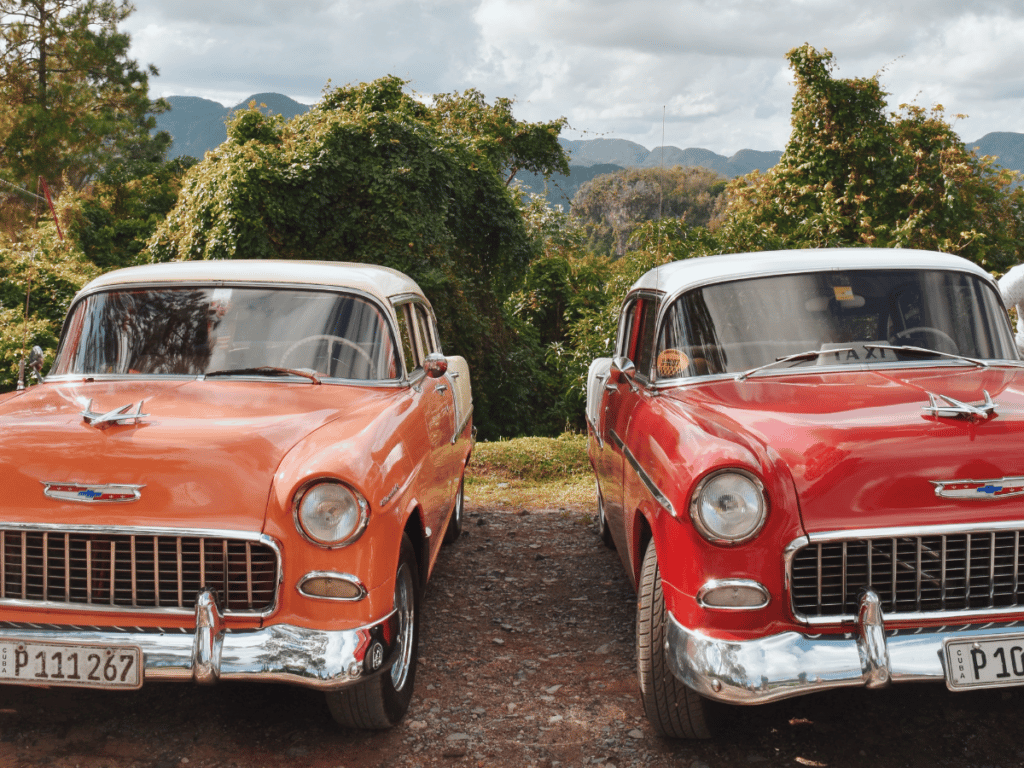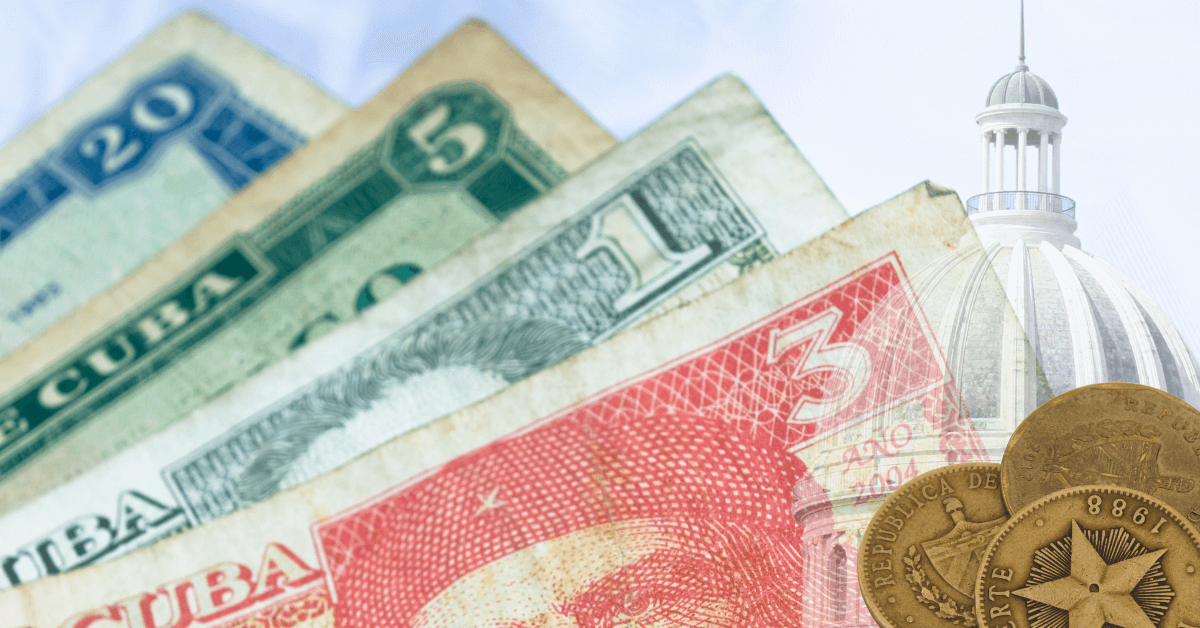Cuba Currency: A Local’s Guide To Currency in Cuba For Travelers [2024 Update]
As recently as three years ago, there were two different types of Cuban currency…and many people in Cuba used them both every day. This is just the start of what is a constantly changing and eternally perplexing situation surrounding Cuba currency and money in Cuba.
As locals, we’re well acquainted with all the details about the ongoing changes to currency in Cuba. In our updated Cuba currency guide for travelers, you’ll find everything you need to know about how to use Cuban pesos, including how to exchange money and what currency to bring to Cuba.

This post contains affiliate links that may reward me monetarily or otherwise when you use them to make qualifying purchases – at no cost to you. As an Amazon Associate, I earn from qualifying purchases. For more information, please read our disclosure policy.
Currency in Cuba
The sole national currency in Cuba is the Cuban Peso, also known as the CUP or simply the peso. It is officially the only currency accepted in Cuba for most transactions.
Bills come in the following denominations: 1, 3, 5, 10, 10, 20, 20, 50, 100, 200, 500 and 1000 pesos. Coins also come in denominations of 1, 3, and 5 pesos in addition to fractional coins, rarely used due to their tiny value.
Exchange Rate in Cuba
The Cuban peso to USD rate has historically been valued at $1 USD = 24 Cuban Pesos (CUP) and is held at this rate, not allowed to fluctuate as most exchanged currencies do. A recent revision of this rate by the Cuban government lifted the exchange rate to $1 = 120 Cuban Pesos (CUP).
Official Cuba Currency Exchange Rate
$1 = 120 Cuban Pesos (CUP)
Because the Cuban peso is held to an official exchange rate, a “black market” for foreign currency is now well established in Cuba, leading to an unofficial exchange rate for Cuban pesos that is much higher than the official exchange rate.
Unofficial Cuba Currency Exchange Rate
$1 = 265 Cuban Pesos (CUP)
While the Cuban government has taken steps to reign in the dual exchange rate, you’ll still find informal money changers paying exchange rates of, at currency revision, around $1 USD = 265+ CUP at the current revision of this article.
This has created an incredibly challenging situation for locals who are seeing the value of their money evaporating rapidly. For travelers to Cuba, it has other consequences, including actually lowering the price of many goods and services for those who travel with cash.

Cuba Currency for Travelers
While the Cuban currency situation can be a bit confusing, especially considering the formal and informal exchange rates caused by inflation, it’s easy enough to manage once you remember these important takeaways:
- Bring Foreign Cash to Cuba
- Exchange Money (Informally) Once You Arrive
- Repeat!
Here are some answers to the Cuba currency questions we’re frequently asked by readers:
What is the Best Currency to Bring to Cuba?
Bring Euros or U.S. Dollars to Cuba if you can. I highly (highly!) recommend that you do not exchange money at the airport or at the CADECA official money exchange locations – speak with your accommodation host and ask where you can exchange your money.
You’ll get triple or quadruple the amount of Cuban pesos if you change your money with an unofficial money changer.
What is the Best Currency to Use in Cuba?
Legally, the only currency you can use in Cuba is the Cuban peso (CUP). However, most Cubans would be glad to accept foreign currency, especially Euros or USD. If you haven’t pre-booked and paid for accommodations, activities, or transportation, you could likely pay for these things in cash in foreign currency.
I don’t recommend trying to pay for things with these currencies directly – change them for Cuban pesos (you’ll get more pesos that way!) – but in a pinch, you won’t have an issue paying for things in foreign currency.
What Kinds of Currency Can I Exchange in Cuba?
Travelers can bring any type of currency to the island and exchange it for pesos upon arrival, though most travelers choose to bring U.S. dollars or Euros. CADECA – the official, state-run money changer in Cuba – will accept many types of currency, including the Mexican peso, Canadian dollar, and more.
What to Bring to Cuba
Check out our Ultimate Cuba Packing List to help you pack for your trip – we’re sharing exactly what to bring to Cuba, and what we never travel without.
Should I Take USD or Euros To Cuba?
We’re often asked – is it better to bring Euros to Cuba than U.S. Dollars? The short answer is no. If you’re traveling from the U.S., don’t exchange your dollars for Euros before arriving. You’ll be paying an exchange fee to do so when U.S. Dollars and Euros are both equally coveted in Cuba.
In previous years there used to be some logic to doing this – there was an additional “tax” on U.S. dollars when exchanged at the state-run money changers, but this is no longer the case.
Should I Take USD or CAD To Cuba?
Canadian travelers also often enquire about whether they should exchange their CAD for USD before arriving in Cuba. Again, the short answer is no. If you’re traveling from Canada, don’t exchange your CAD for USD or Euros before arriving. The same goes for U.S. travelers.
You’ll be paying an exchange rate to change your home currency before arriving. USD, CAD, and Euros alike are all equally coveted in Cuba, so there’s no need to eat the cost of an additional money exchange fee.
In previous years there used to be some logic to doing this – there was an additional “tax” on U.S. Dollars when exchanged at the state-run money changers, but this is no longer the case.
Should I Bring Cash to Cuba?
When you exchange money at the official, state-run CADECA money exchange locations throughout the country or in the airport, you’ll get the $1 USD = 120 CUP Cuban peso to USD exchange rate. You’ll also get this exchange rate when withdrawing money from an ATM or bank.
For this reason, we recommend travelers do not plan on withdrawing money from Cuban ATMs but rather bring cash in their home currency to the island, and then exchange it at an informal exchange spot. If you take anything away from this article, let this be it!
Why? Say you want to exchange $100 USD for Cuban pesos. If you withdraw it from an ATM, you’ll receive 12,000 CUP. However, if you exchange $100 USD in cash at an informal exchange spot, you’d get (given current informal exchange rates) about 26,500 CUP – that’s more than double the amount of money!
An important note for U.S. travelers: bringing cash from home is NOT optional for you. Because of the U.S. embargo against Cuba, your bank cards and credit cards will not work in Cuba, and there is no way around this – you MUST bring all the cash you’ll need for the duration of your trip! Read our guide to travel to Cuba from the United States for more details.
Can I Still Use the Cuban Convertible Peso?
From its start, the convertible peso was the currency of Cuba intended for foreign transactions, and the CUC was mostly used in the tourism industry. After operating with two currencies in Cuba – the Cuban peso (CUP) and the Cuban convertible peso (CUC) – since the 1990s, in January 2021, Cuba adopted the Cuban peso as its sole currency.
While it is no longer in use, you may find some publications locally and internationally that may still reference it.
The former exchange rate for the CUC was pegged to the U.S. dollar, 1 CUC = 1 USD. For the first few months of 2021, the government continued to accept CUC and allow people to change their CUC to Cuban pesos. This is now no longer the case – CUC bills are now worthless.

Exchange Money in Cuba
Unlike other currencies that can be exchanged anywhere in the world, you can’t get Cuban pesos off the island – you’ll have to wait to get it until you arrive and then exchange money in Cuba. This means you should bring cash with you to Cuba and exchange it once you arrive.
At the airport, when you arrive, do NOT immediately change your currency into Cuban pesos. At the official money changer at the airport, you’ll get a lower exchange rate. Instead, wait until you arrive at your destination – go ahead and pay your taxi driver in foreign currency; they’ll be thrilled by that!
Once you’ve arrived at your destination, ask at your accommodation for informal money changers. Any casa particular owner or host can direct you to the money changer they use and will likely have them on speed dial, able to come to the house. They may even be able to do it for you! This will get you that better exchange rate you’re after.
Where to Exchange Money in Cuba
If you’re staying in a casa particular guest house or an Airbnb, your host will let you know where to change money, formally or informally. Informal money changing arranged through casa particular or Airbnb hosts is quite safe and secure, as the hosts know that their rental business relies on their guests having a good experience.
If you’re staying in a hotel, it’s still worth asking the staff where to exchange money informally. They might be able to direct you to someone. If they only direct you to a CADECA (the state-run money changers), you can ask in other tourist establishments like restaurants or bars if they know an informal money changer.
This type of money changing in Cuban currency is so common nowadays in Cuba that most Cubans do it on a regular basis as a part of their day-to-day. Of course, take basic safety precautions, but don’t fear – you’ll be fine.
Remember not to change all of your money at once. As you start to see how much you’re spending each day, you’ll be able to exchange more money later on in your trip – it’s better not to exchange too much money and get stuck with leftover pesos at the end of your trip.
Read More: Is Cuba Safe? Cuba Satefy Guide + Local Tips

Currency in Cuba for American Travelers
An important reminder if your banking is set up in the United States, you won’t be able to use your debit card or credit card at all while in Cuba due to U.S. sanctions on Cuba. While this is due to the U.S. embargo on Cuba rather than the Cuba currency situation itself, it’s definitely something to be aware of as you prepare for your visit.
If your banking is through a U.S. bank – or your credit cards are issued in the United States, you’ll need to bring ALL the money you’ll use during the duration of your trip in cash with you when you arrive.
Here’s a needed safety reminder – don’t carry all of your money with you at once! Everyone knows the money in Cuba situation means travelers are walking around with more cash these days, so only carry around exactly what you need; leave the rest locked up in your casa particular or hotel room, just in case you were to get pickpocketed.
Travel to Cuba From the United States
Currency in Cuba for Non-U.S. Travelers
Visitors who have credit cards and bank accounts outside of the United States should have no issues accessing their money here. Any money withdrawn from ATMs or banks will be in Cuban pesos.
However, some online banking apps (like Paypal and others) are regularly blocked by the United States for all users here, so I recommend downloading a VPN (a virtual private network) like NordVPN to make sure you can still access online banking here.
Even if you’re not very tech-savvy, NordVPN is very easy to use. Just hit a button on your phone or computer, and you’re instantly connected to a secure network that makes it look like you’re accessing the internet from another country, avoiding blocks, and staying safe online.
Even if your banking is not set up in the United States, I recommend bringing as much money in cash as you can. With the informal exchange range and the official one being so different, you’ll save significantly.
Plus, banks tend to have long lines here, and ATMs can sometimes be hard to find, especially if you won’t be staying in a bigger city like Havana. You wouldn’t want to get stuck without cash in Cuba.
Read More About Internet in Cuba

Carley Rojas Avila is a bilingual travel writer, editor, content marketer, and the founder of the digital travel publications Home to Havana and Explorers Away. She is a serial expat and traveler, having visited 40+ countries and counting. Carley has written for publications like Travel + Leisure, MSN, Associated Press, Weather Channel, Wealth of Geeks, and more. Find her front row at a Bad Bunny concert, befriending street cats, and taste-testing every pizza in Havana.

